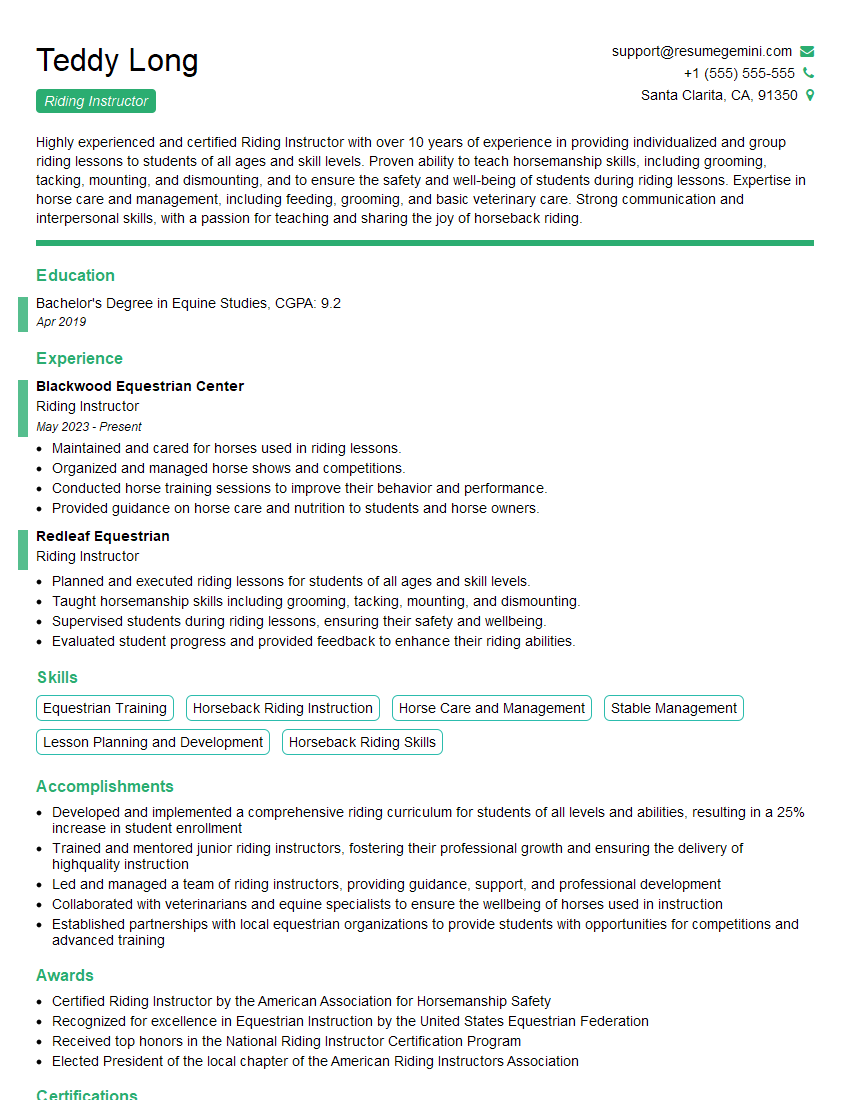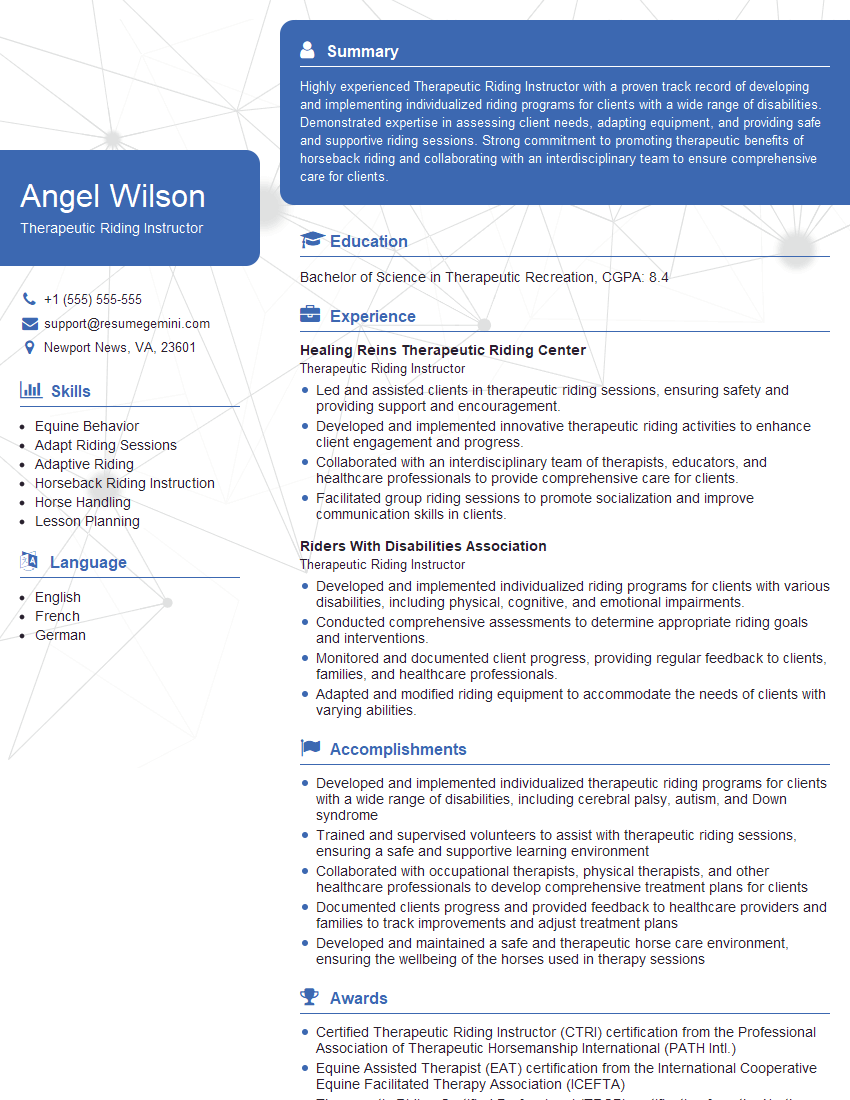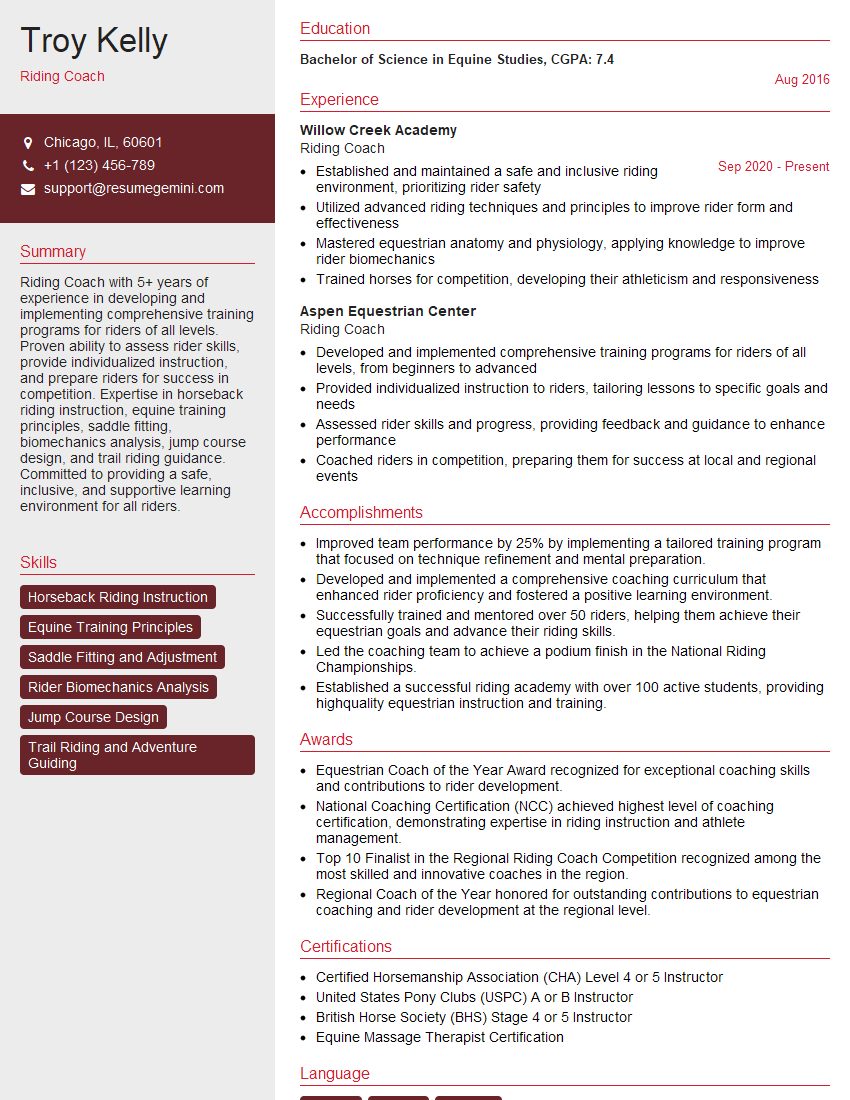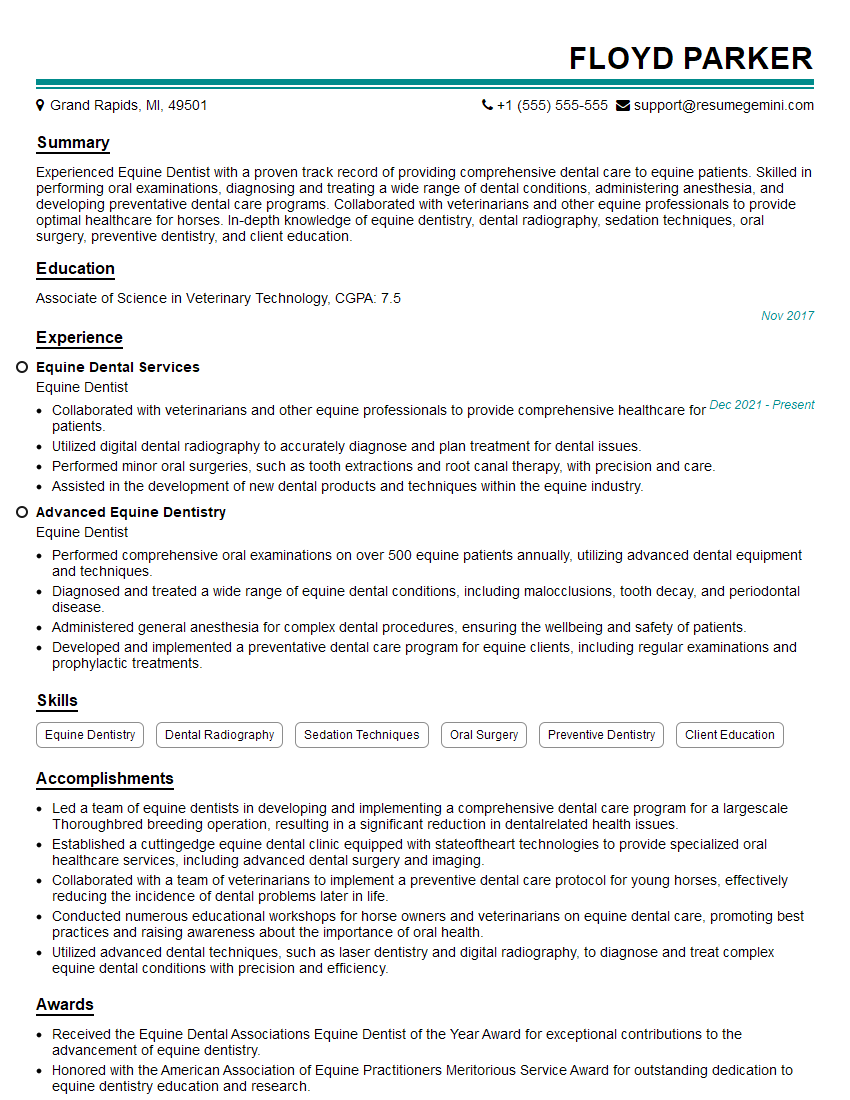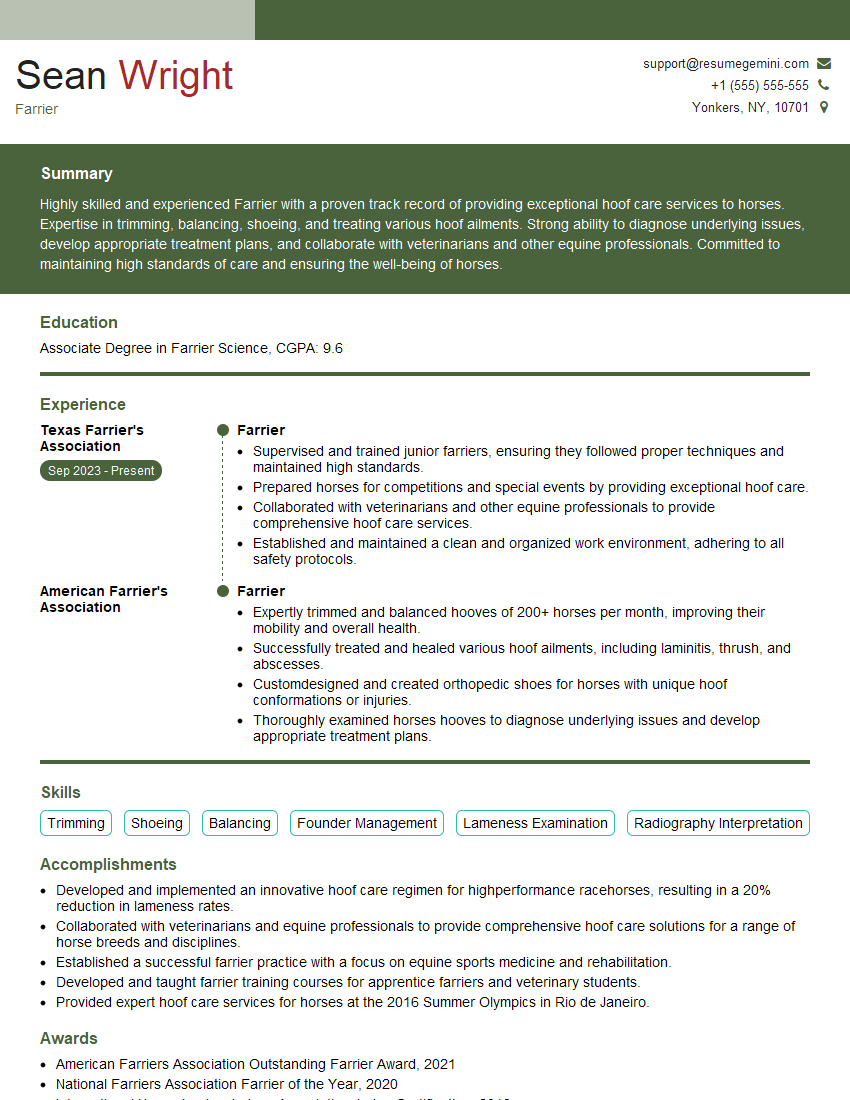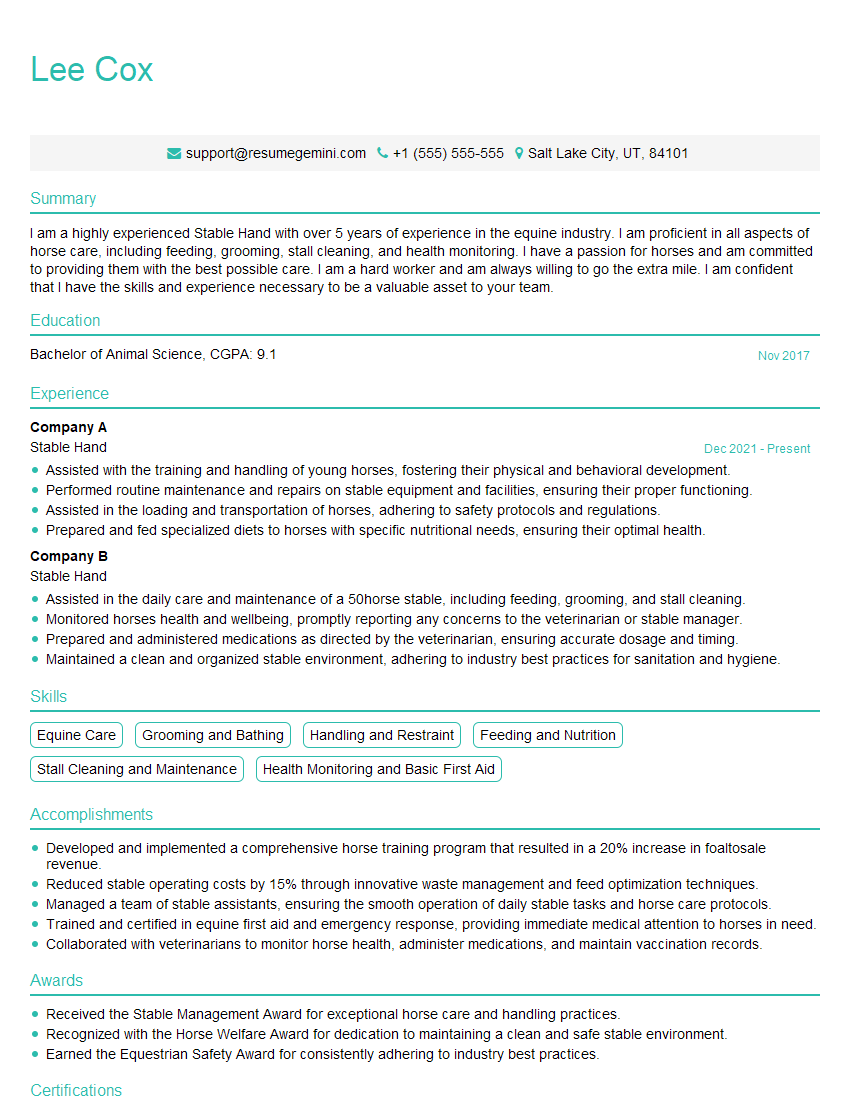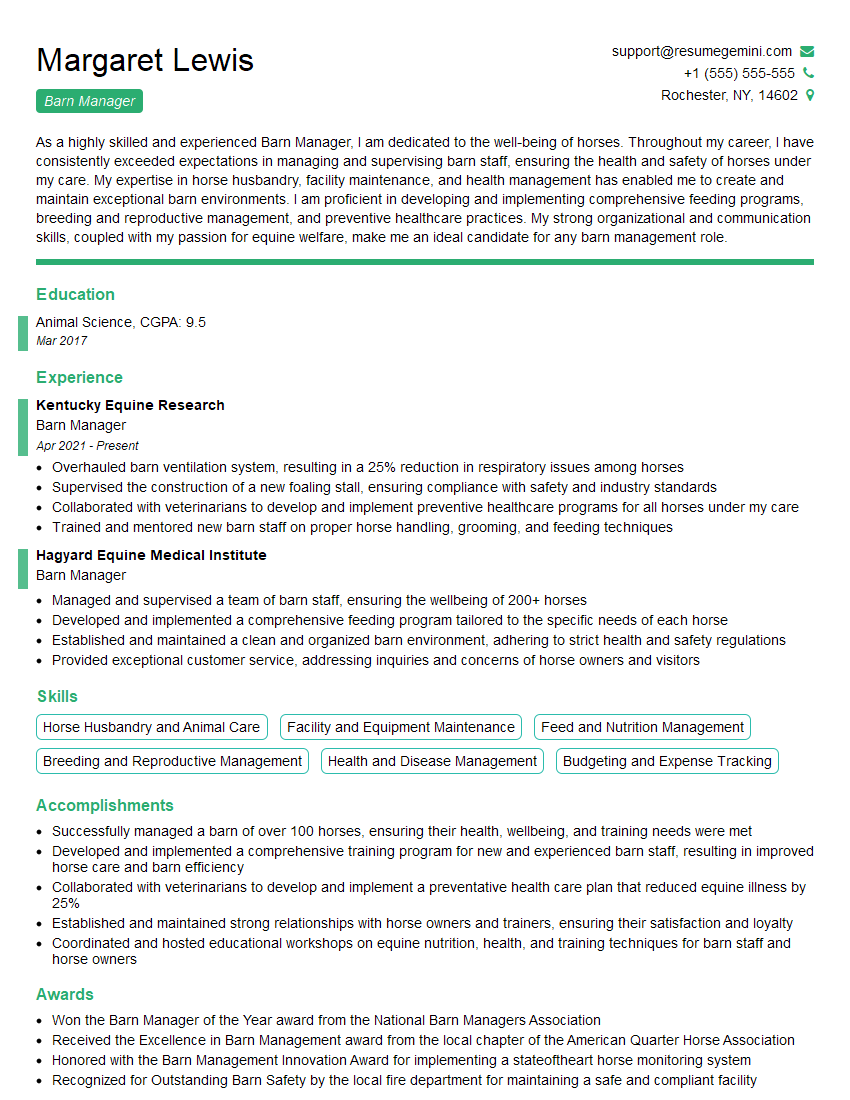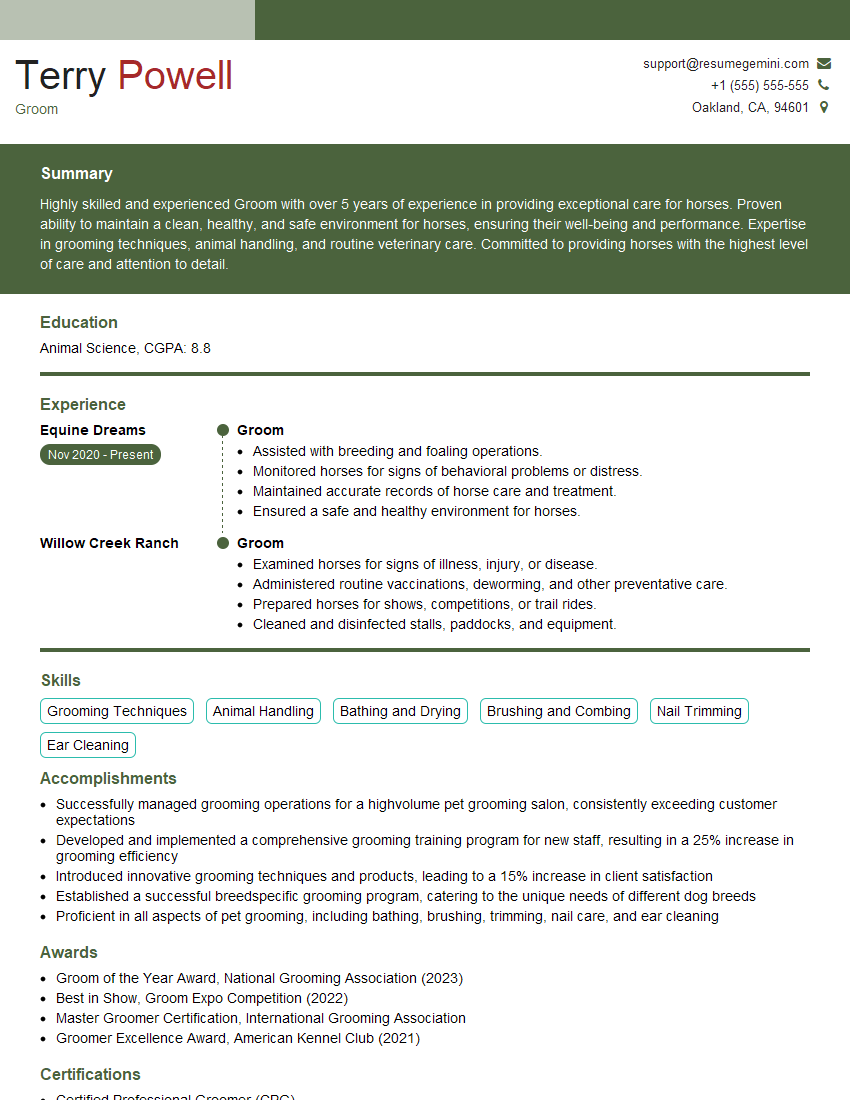Unlock your full potential by mastering the most common Equestrian Training interview questions. This blog offers a deep dive into the critical topics, ensuring you’re not only prepared to answer but to excel. With these insights, you’ll approach your interview with clarity and confidence.
Questions Asked in Equestrian Training Interview
Q 1. Describe your experience with different horse breeds and their unique training needs.
My experience spans a wide range of horse breeds, each presenting unique training challenges and rewards. For instance, the powerful and athletic Thoroughbred requires a different approach than the calm and sturdy Quarter Horse. Thoroughbreds, known for their sensitivity and speed, benefit from clear, concise communication and consistent training focused on building trust and refining their natural athleticism. They need firm but fair handling, understanding their tendency towards excitability. In contrast, Quarter Horses, often used for versatility in disciplines like western riding and reining, respond well to positive reinforcement and clear cues. Their calm temperament makes them easier to train initially, but consistent training to address potential stubbornness is vital. Working with Warmbloods, bred for dressage and jumping, involves developing their strength, suppleness, and precision. They respond well to dressage techniques, but require patience and understanding of their sometimes sensitive nature. Each breed’s unique conformation, temperament, and historical usage informs my training approach, emphasizing individualized instruction rather than a one-size-fits-all methodology.
Q 2. Explain your approach to correcting common riding faults.
Correcting riding faults requires a holistic approach that addresses both the rider’s technique and the horse’s response. My approach focuses on identifying the root cause of the fault, not just the symptom. For example, if a rider is experiencing difficulty with their horse’s transitions, I might analyze their seat, leg position, and rein aids to pinpoint inconsistencies. Then, through a series of exercises, I’ll guide the rider in refining their technique, focusing on independent seat, leg, and rein aids, and emphasizing clear and precise cues. Simultaneously, I assess the horse’s responsiveness and adjust the exercises based on their comfort and understanding. I might incorporate groundwork exercises to improve the horse’s responsiveness to cues before mounting, ensuring a solid foundation for improved riding. I believe in positive reinforcement, rewarding correct responses and gently correcting mistakes rather than resorting to harsh methods. I often use visualization techniques, helping riders to mentally rehearse correct movements before physically attempting them, enhancing body awareness and coordination. The goal is to build a harmonious partnership between horse and rider, achieving smooth, effortless movements based on mutual understanding.
Q 3. How do you assess a horse’s temperament and adjust your training accordingly?
Assessing a horse’s temperament is crucial for effective training. I start by observing the horse in its environment – its behavior in the paddock, its response to handling, and its interaction with other horses. I pay close attention to its body language – ears, tail, and eye position – which provides valuable insights into its mood and anxieties. A horse that readily approaches and accepts handling usually exhibits a confident and trusting temperament, whereas a horse that is tense or evasive may be showing fear or anxiety. Based on these observations, I tailor my training approach. For a fearful horse, I prioritize building trust through gentle handling, positive reinforcement, and desensitization exercises. For a more dominant or assertive horse, I maintain clear leadership through calm but firm handling, establishing a respectful hierarchy. I use a variety of techniques, from groundwork to mounted work, adapting the intensity and complexity of exercises based on the horse’s responses, always prioritizing its comfort and safety. The ultimate aim is to foster a trusting and cooperative relationship which forms the basis for successful training.
Q 4. What methods do you use to build trust and rapport with horses?
Building trust and rapport with horses is foundational to successful training. I begin by establishing a calm and respectful presence, avoiding sudden movements or loud noises. Gentle touch is important; I’ll spend time grooming the horse, observing its responses and building a connection through touch and communication. I use positive reinforcement techniques consistently, rewarding desired behaviours with praise, treats, or gentle scratches. Groundwork exercises, such as leading, lunging, and desensitization, play a vital role in establishing mutual understanding and trust. These exercises allow the horse to understand my cues and build confidence in my leadership. I believe in observing the horse carefully and responding to its individual needs and preferences; this might involve taking more time with a nervous horse, offering reassurance through calm voice and touch, or taking a break if the horse appears stressed. My primary goal is to cultivate a calm, cooperative relationship where the horse feels safe and understood.
Q 5. Describe your experience with different riding disciplines.
My experience encompasses various equestrian disciplines, providing a broad perspective on training techniques and horse management. I have significant experience in dressage, focusing on developing the horse’s suppleness, balance, and precision through careful and systematic training. This includes working on collection, transitions, and lateral movements. My experience in jumping involves training horses to clear obstacles safely and effectively, emphasizing technique and strength. This includes teaching the horse proper take-off and landing techniques and building its confidence over progressively larger fences. I’ve also worked extensively with western riding, concentrating on developing the horse’s responsiveness to subtle cues and its ability to perform maneuvers smoothly and efficiently. This involves mastering techniques such as reining, sliding stops, and rollbacks. This diverse background allows me to tailor my training approach to meet the specific demands of each discipline and the individual horse’s capabilities and temperament.
Q 6. How do you handle challenging or aggressive horses?
Handling challenging or aggressive horses requires patience, experience, and a deep understanding of equine behavior. The first step is to identify the root cause of the aggression, which may stem from fear, pain, or past negative experiences. I prioritize safety by working with experienced handlers and using appropriate equipment, such as protective gear and specialized halters. Desensitization techniques play a crucial role in gradually introducing the horse to potentially triggering stimuli, doing so in a controlled environment and at the horse’s pace. I might use groundwork exercises to establish clear communication and build trust before attempting any mounted work. Positive reinforcement remains central, rewarding calm behavior and avoiding actions that might trigger aggressive responses. If aggression persists despite these measures, I’d consult with a veterinarian or equine behaviorist to rule out any underlying medical conditions or psychological issues. Patience and consistency are key when working with challenging horses; progress may be slow, but it is crucial to maintain a calm and respectful approach throughout the process.
Q 7. What safety protocols do you consistently implement during training?
Safety is paramount in all my training sessions. I consistently implement a range of protocols, beginning with a thorough pre-ride inspection of tack and equipment for any damage or wear. I always inspect the arena for hazards before starting a session. I ensure the horse is appropriately fitted with tack and that it is in good health, consulting with a vet if needed. Before mounting, I perform groundwork to assess the horse’s state of mind. During the session, I maintain awareness of the horse’s behavior, avoiding actions that might trigger a negative reaction. My communication with the horse is always clear and consistent, using gentle aids and positive reinforcement. I always have a designated handler present, particularly when working with young or challenging horses, and never work alone. After each session, I inspect the horse and the equipment again to ensure they are undamaged and that the horse is well-cared for. This multi-layered approach ensures safety for both horse and rider throughout each training session.
Q 8. Explain your understanding of horse anatomy and how it impacts training.
Understanding horse anatomy is fundamental to effective equestrian training. A horse’s musculoskeletal system, in particular, dictates its movement and capabilities. For example, the conformation of the legs – the angles of the joints, the length of the bones – directly impacts stride length, balance, and susceptibility to injury. A horse with long, sloping shoulders will likely have a longer stride than one with shorter, upright shoulders. Similarly, the structure of the back impacts its ability to carry weight and perform collected movements. A weak or uneven back can lead to discomfort and resistance during training.
Understanding the horse’s digestive system is also crucial. Horses are hindgut fermenters, meaning their digestive process relies heavily on microbial fermentation in the cecum and colon. Knowing this influences feeding strategies and helps prevent digestive upset, which can significantly impact a horse’s performance and temperament. For instance, sudden diet changes can disrupt the gut microbiome and lead to colic, making regular, gradual changes essential.
Finally, understanding the horse’s nervous system is vital for effective communication. A horse’s response to training cues depends heavily on its sensitivity and perception. A highly sensitive horse might require gentler techniques than a less sensitive one. Knowing the anatomy of the nervous system, including the intricate communication pathways between brain and muscles, enables riders to develop more precise and responsive training methods.
Q 9. How do you diagnose and address lameness in a horse?
Diagnosing lameness in a horse requires a systematic approach. I start by observing the horse’s gait at various speeds and from different angles. Asymmetry in movement – a shorter stride on one leg, for instance – is a key indicator. I then palpate the horse’s legs, checking for heat, swelling, or pain. Any abnormalities detected during observation and palpation guide further investigation.
Advanced diagnostics may include flexion tests, where a joint is flexed for a short period and the horse is then trotted out to observe any exacerbation of lameness. Radiography (X-rays) and ultrasonography can help identify underlying bone or soft tissue issues. In complex cases, a veterinary consultation is essential for a thorough assessment and potential treatments, which might range from corrective shoeing to medication or surgery. Managing lameness might involve rest, therapeutic treatments, and a tailored rehabilitation plan to gradually return the horse to work. The key is to focus on the underlying cause of the lameness, rather than just masking the symptoms.
Q 10. What are your preferred methods for teaching different riding skills (e.g., transitions, lateral movements)?
My approach to teaching riding skills emphasizes clear communication, positive reinforcement, and progressive training. For transitions, I begin with simple walk-to-halt transitions, focusing on precise timing and rider aids. Gradually, we incorporate halt-to-walk, walk-to-trot, and trot-to-walk transitions, ensuring the horse responds smoothly and willingly to each cue. I use voice commands and the lightest aids possible, gradually increasing the intensity only if needed. The goal is to establish a clear understanding between horse and rider, enabling seamless and accurate transitions.
For lateral movements, like shoulder-in or leg yields, I start with groundwork exercises to improve the horse’s suppleness and responsiveness. This might involve in-hand work to encourage bending and lateral flexion. When mounted, I use half-halts and subtle aids to guide the horse into the movement, rewarding any correct attempts with praise and release of pressure. Progress is incremental and tailored to the horse’s abilities and learning pace. I also believe in regularly reviewing previous exercises to maintain consistent response to aids. I use a combination of positive reinforcement, such as verbal praise and scratches and clear corrections, avoiding harsh techniques.
Q 11. Describe your experience with young horses and their development.
Working with young horses is rewarding but demands patience and a deep understanding of their developmental stages. My approach emphasizes early socialization, exposing the foal to various sights, sounds, and experiences in a controlled and positive manner. Handling and ground work begin early, building trust and respect. I focus on building a strong foundation of basic skills like leading, grooming, and accepting handling of their feet. This early groundwork builds confidence in the horse and provides a solid base for future training under saddle.
As the young horse matures, I start under saddle work gradually, starting with short sessions and focusing on relaxation and suppleness. I avoid pushing the horse beyond its physical or mental capabilities. Progress should be slow and steady, with ample time for rest and recovery. The goal is to develop a well-balanced, confident horse that is willing and responsive to the rider’s aids. Regular veterinary checkups and farrier visits are crucial to monitor the horse’s growth and overall health.
Q 12. How do you manage a horse’s health and nutrition?
Managing a horse’s health and nutrition requires careful attention to several aspects. The foundation is a balanced diet tailored to the horse’s individual needs, considering factors such as age, breed, workload, and overall health. This involves high-quality forage, appropriate amounts of grain (if necessary), and supplements to address any nutritional deficiencies. Regular dental checkups are crucial, as dental problems can significantly impact a horse’s ability to eat effectively.
Routine parasite control is essential to prevent internal and external parasites that can cause significant health issues. A veterinarian can recommend a suitable deworming program. Regular hoof care, including trimming and shoeing (if required), prevents hoof problems that might compromise the horse’s soundness. A clean and safe environment, providing adequate shelter and turnout time, contributes to the horse’s overall well-being. Regular veterinary checkups and prompt attention to any signs of illness or injury are paramount in maintaining optimal health. I emphasize preventative care rather than solely focusing on treating existing problems.
Q 13. Explain your understanding of equine biomechanics.
Equine biomechanics is the study of the horse’s movement and how it interacts with its environment. It’s a crucial part of my understanding of training because it allows me to analyze and optimize the horse’s movement for performance and well-being. Understanding the forces acting on the horse’s body during movement helps prevent injuries and improve efficiency.
For instance, analyzing the horse’s stride helps me identify areas of potential weakness or imbalance. A horse with a short, choppy stride might be exhibiting stiffness or pain, requiring specific exercises to improve flexibility and range of motion. Conversely, a horse with an excessively long stride might be overextending its joints, increasing its risk of injury. Understanding the principles of balance and coordination allows me to design training programs that enhance the horse’s natural movement patterns and reduce stress on its joints and muscles. This understanding also allows me to accurately assess the impact of different training techniques on the horse’s biomechanics, ensuring that my methods promote optimal performance and prevent injury.
Q 14. What is your experience with using different training equipment (e.g., bridles, saddles)?
My experience with different training equipment is extensive. I select equipment based on the individual horse’s needs and the specific training goals. For bridles, I consider the horse’s temperament and sensitivity, opting for gentler options like snaffles for sensitive horses and stronger bits for more experienced mounts only when truly needed. I prioritize well-fitting bridles to avoid discomfort and pressure points. I understand different bits’ mechanics and how they impact the horse’s responsiveness, and I do not use harsh bits unless absolutely necessary, considering it as a last resort.
Regarding saddles, I prioritize comfort and proper fit for both horse and rider. A well-fitted saddle distributes weight evenly across the horse’s back, preventing discomfort and potential injuries. I use different saddle types depending on the discipline and the horse’s conformation, ensuring correct saddle placement to enhance performance and avoid injuries. For example, a dressage saddle encourages a specific posture promoting collection, while a western saddle is designed for a different riding style. Always, the fit, comfort, and effect of the equipment on the horse’s biomechanics and well-being are my priority.
Q 15. Describe your approach to dealing with horse injuries.
My approach to horse injuries prioritizes prompt assessment, immediate first aid, and swift veterinary intervention. I’ve found that a calm and methodical approach is crucial, both for the horse’s well-being and my own ability to act effectively.
First, I assess the situation for immediate danger – is the horse in a safe location? Are there any further injuries that could occur (e.g., from a fall)? Then, I perform a careful visual examination, noting the location, severity, and type of injury. This assessment includes checking for lameness, swelling, bleeding, or any other abnormalities.
Once the initial assessment is complete, I administer appropriate first aid – this might involve cleaning a wound, applying a cold compress to reduce swelling, or splinting a fracture (only if I’m comfortable doing so and it doesn’t risk further harm). Crucially, I always prioritize minimizing the horse’s stress and pain during this process using calming techniques.
Finally, I contact a veterinarian immediately. Clear, concise communication with the vet is essential, including details of the injury, the first aid provided, and the horse’s current condition. I follow the vet’s instructions precisely and keep a detailed record of the incident, treatment, and the horse’s subsequent progress.
For example, I once dealt with a horse who cut its leg badly in the field. I immediately assessed the situation for safety, cleaned the wound with sterile saline, and applied a pressure bandage to control the bleeding before contacting my equine vet. The prompt action prevented infection and allowed for rapid healing.
Career Expert Tips:
- Ace those interviews! Prepare effectively by reviewing the Top 50 Most Common Interview Questions on ResumeGemini.
- Navigate your job search with confidence! Explore a wide range of Career Tips on ResumeGemini. Learn about common challenges and recommendations to overcome them.
- Craft the perfect resume! Master the Art of Resume Writing with ResumeGemini’s guide. Showcase your unique qualifications and achievements effectively.
- Don’t miss out on holiday savings! Build your dream resume with ResumeGemini’s ATS optimized templates.
Q 16. How do you create and maintain a positive training environment?
Creating and maintaining a positive training environment hinges on understanding and respecting the horse’s individual needs and personality. My approach emphasizes clear communication, patience, and positive reinforcement.
I prioritize building trust with each horse through consistent, predictable interactions. This includes gentle handling, offering rewards for positive behavior, and avoiding harsh corrections. A positive training environment is one where the horse is relaxed, willing to participate, and enjoys the interaction.
- Clear Communication: I use clear and consistent cues, ensuring that the horse understands what is expected of it.
- Positive Reinforcement: I reward desired behaviors with praise, treats, or a release of pressure. I focus on what the horse is doing well, rather than dwelling on mistakes.
- Patience and Understanding: I understand that horses learn at different paces, and I adjust my approach accordingly. I never rush the process.
- Safe and Comfortable Environment: I maintain a safe and clean training area, free of distractions. The equipment I use should be appropriately fitted and well-maintained.
For instance, if a horse is struggling with a specific exercise, I break it down into smaller, more manageable steps. I also incorporate regular breaks and vary the training sessions to maintain engagement and prevent boredom. The overall goal is to create a learning environment where the horse feels comfortable, confident, and motivated to learn.
Q 17. How do you adapt your training methods for riders of different skill levels?
Adapting my training methods for different skill levels is essential for ensuring safety, progress, and enjoyment. I tailor my instruction to the rider’s experience, physical abilities, and learning style.
For beginner riders, I start with basic groundwork, focusing on building confidence and developing a strong foundation. I introduce riding gradually, emphasizing proper posture, balance, and communication with the horse. Sessions are shorter and more focused, with plenty of time for questions and clarification.
Intermediate riders have a basic understanding of riding, so I introduce more advanced techniques, such as transitions, lateral movements, and more challenging exercises. I offer constructive feedback, helping them refine their skills and develop a more independent riding style.
Advanced riders seek to further refine their skills and potentially compete. With them, I focus on perfecting techniques, developing subtle aids, and enhancing communication with the horse. Our sessions often involve tackling more complex movements and strategizing for competitions. I foster self-reliance and critical thinking.
Throughout all levels, safety remains paramount. I emphasize proper riding attire, correct use of equipment, and risk management strategies. I adapt my communication to the rider’s needs, using clear and concise language while ensuring they understand the reasons behind my instructions.
Q 18. Explain your experience with different types of tack and their proper use.
My experience encompasses various types of tack, from basic bridles and saddles to more specialized equipment. Proper use is crucial for both horse comfort and rider effectiveness.
Bridles: I’m proficient with snaffles, double bridles, and hackamores. The choice depends on the horse’s temperament, training level, and the rider’s skill. Improper use of any bridle can cause pain or discomfort. I carefully consider the bit size and type, ensuring a proper fit to prevent mouth sores.
Saddles: I’m familiar with English and Western saddles, understanding the differences in their design and functionality. Proper saddle fit is essential; I regularly check for proper balance and pressure distribution to avoid back problems. Saddle pads also play a vital role in distributing pressure correctly.
Other Tack: I’m experienced with girths, breastplates, martingales, and other auxiliary tack. Each item has its purpose and must be used correctly. For example, a martingale should be used only as a training aid and should not restrict the horse’s movement. Similarly, breastplates should be properly fitted and adjusted for additional security without impeding the horse’s natural movement.
Maintenance: Regular cleaning and inspection of all tack are essential. I ensure that all leather goods are properly conditioned, and that metal parts are free from rust and damage. This extends the lifespan of equipment and prevents potential harm to the horse.
Q 19. How do you maintain proper horse care (grooming, feeding, stabling)?
Proper horse care is paramount. It encompasses grooming, feeding, and stabling, all crucial aspects of ensuring a horse’s health and well-being.
Grooming: Daily grooming is essential for maintaining the horse’s coat, skin, and overall hygiene. It includes currying, brushing, picking hooves, and cleaning the horse’s tail and mane. Grooming allows for early detection of skin conditions or injuries.
Feeding: I tailor feeding plans to the horse’s individual needs, considering factors like age, breed, workload, and health status. The diet typically includes hay, grain, and supplements, balanced to provide the necessary nutrients. Regular dental check-ups are vital, as dental problems can impact feeding efficiency.
Stabling: I ensure the horse has a clean, dry, and spacious stall or paddock. Proper ventilation and temperature control are key. I regularly clean the stall, removing manure and soiled bedding. I also provide fresh water frequently. Overcrowding or poor hygiene can result in respiratory problems or other health issues.
I constantly monitor my horses for any signs of illness or injury, adjusting their care as needed. Regular vet checks and farrier visits are also crucial elements of my overall care plan. A healthy horse is a happy horse, and diligent care goes a long way in ensuring this.
Q 20. What is your experience with equine first aid?
I have extensive experience in equine first aid, having taken certified courses and regularly updating my knowledge. I’m confident in handling various emergency situations.
My skills include wound cleaning and bandaging, controlling bleeding, splinting fractures (when appropriate and safe), administering oral medications as directed by a vet, and recognizing and responding to colic, heatstroke, and other emergencies.
I understand the importance of staying calm under pressure and prioritizing the horse’s safety and comfort. My training emphasizes a systematic approach to assessment and treatment, ensuring appropriate actions and preventing further harm. My kit is always stocked with essential supplies, from bandages and antiseptic solutions to wound dressings.
For example, recognizing the signs of colic – intense abdominal pain manifested as pawing, rolling, and kicking – is critical. Prompt veterinary attention is crucial in colic cases. I’m skilled at managing the horse during this stressful period, minimizing further distress while awaiting veterinary intervention.
Q 21. Describe your understanding of horse behavior and psychology.
Understanding horse behavior and psychology is fundamental to successful training and safe handling. I approach each horse as an individual, recognizing their unique personalities, experiences, and learning styles.
Body Language: I’m adept at interpreting equine body language, recognizing subtle cues like ear position, tail carriage, and eye movements. This helps me understand their emotional state, assess their comfort level, and anticipate potential problems. A relaxed horse will have loose muscles, soft eyes, and a relaxed posture. A tense or fearful horse will exhibit stiff muscles, pinned ears, and a raised tail.
Learning Styles: Some horses learn quickly through positive reinforcement, while others need a more patient and structured approach. I adapt my methods accordingly, always respecting the horse’s boundaries and preferences.
Hereditary and Environmental Factors: I take into account the horse’s breed, background, and experiences. A horse that has had negative experiences may exhibit fear or anxiety, requiring a particularly sensitive and patient approach.
Building Trust: Building a trusting relationship is vital. This starts with respectful handling and gentle interactions, providing a safe and predictable environment. The horse needs to learn that the human is a source of comfort and safety, not a source of fear or anxiety.
Q 22. How do you handle emergency situations involving horses?
Handling emergencies with horses requires quick thinking and decisive action. The first priority is always safety – both yours and the horse’s. My approach is based on a systematic assessment and response, prioritizing immediate threats.
- Assess the situation: What is the emergency? Is the horse injured? Is there a threat to others? Is the horse panicked or in immediate danger of harming itself or others?
- Secure the area: If possible, move other horses and people to a safe distance to prevent further incidents. This might involve using halters, lead ropes, or other available means of restraint.
- Provide immediate care (if necessary): If the horse is injured, provide first aid – this could range from applying pressure to a wound to stabilizing a broken leg until veterinary help arrives. Knowing basic equine first aid is absolutely crucial.
- Contact emergency services: Call a veterinarian, emergency services, or an experienced equine professional. Clearly and calmly describe the situation, location, and the horse’s condition.
- Remain calm and assess further: Once the immediate danger has passed, reassess the situation, potentially investigating the cause of the emergency to prevent recurrence.
For example, if a horse panics and breaks free from its stall, my immediate response would be to secure the area, attempting to gently coax the horse toward a safer location rather than directly chasing after it, potentially escalating the panic. If the horse is injured during the escape, I prioritize first aid and immediately contact emergency services.
Q 23. Describe your experience with the different stages of horse development.
Understanding the different stages of horse development is paramount for effective training. Each stage presents unique challenges and opportunities.
- Foal (0-1 year): This stage focuses on socialization, handling, and basic training around human interaction. It’s about establishing trust and building a foundation for future training. We’re teaching them to accept touch, leading, and basic handling techniques.
- Yearling (1-2 years): Yearlings are still developing physically and mentally. Training at this stage is gentler and more focused on continued socialization and introducing basic ground work exercises, such as leading and desensitization to various objects and stimuli. The focus is on building confidence and positive interactions.
- Two-Year-Old: This stage involves introducing under saddle work – beginning with very short sessions, focusing on correct posture and balance. Proper groundwork is extremely important. It’s about building a strong foundation and making sure the horse is comfortable under saddle.
- Three-Year-Old and beyond: More advanced training begins, depending on the horse’s discipline (jumping, dressage, Western etc.). The horse is physically more mature, allowing for more intense work. At this stage, refinement of skills and techniques becomes the focus.
I’ve worked with horses at all these stages, and each phase requires a different approach, understanding the horse’s physical and mental capabilities is key for safe and effective training. Patience is vital.
Q 24. What is your approach to problem-solving in horse training?
My approach to problem-solving in horse training is rooted in a systematic process and a deep understanding of equine behavior.
- Identify the problem: Clearly define the behavior issue – is the horse refusing a jump, exhibiting anxiety, or exhibiting other behavioral problems?
- Analyze the cause: Consider the possible reasons for the behavior. Is it physical discomfort, a lack of understanding, fear, or a previous negative experience? Observe the horse’s body language carefully.
- Develop a solution: Based on the cause, develop a training plan. This might involve desensitization exercises, positive reinforcement techniques, or addressing potential physical issues through a veterinarian consultation.
- Implement and evaluate: Put the training plan into action and carefully observe the horse’s response. Be prepared to adjust your approach as needed.
- Positive reinforcement: I use positive reinforcement as a core strategy. Reward desired behaviors promptly to reinforce them. This strengthens the horse-human bond.
For example, if a horse is refusing to jump, I would first rule out any physical issues (vet check). Then I’d analyze its behavior – is it fearful, lacking confidence, or simply not understanding the cue? I’d then use positive reinforcement, starting with smaller obstacles and gradually increasing the height and complexity, rewarding the horse for each successful attempt.
Q 25. How do you assess the progress of a horse and rider?
Assessing the progress of a horse and rider involves a multifaceted approach that considers both technical skill and the overall partnership.
- Technical skills: Observe the rider’s position, the horse’s gait and form, and the execution of specific movements. Are they achieving correct form, maintaining rhythm and balance?
- Partnership: Evaluate the communication between horse and rider. Is there a clear understanding between them? Is the horse responding willingly and confidently, showing signs of relaxation and engagement?
- Consistency: Observe consistency in performance over time. Progress isn’t always linear. Setbacks are normal, but an overall trend of improvement should be evident. Tracking progress through video recording and notes is invaluable.
- Goals and objectives: Assess progress in relation to specific training goals and objectives. Are they reaching milestones at a safe and sustainable pace?
For example, I might track a dressage rider’s improvement by noting their ability to execute a specific movement (like a half-pass) over several training sessions, paying attention to the quality of the movement, the horse’s responsiveness, and the rider’s overall position. Are they becoming more precise and fluid over time?
Q 26. What are your career goals within the equestrian field?
My career goals are centered around continued excellence in equestrian training and education. I aim to become a respected and sought-after instructor, helping riders of all levels achieve their equestrian aspirations in a safe and supportive environment.
- Advanced training: I plan to pursue further education and certifications to enhance my expertise in various disciplines.
- Mentorship and instruction: I’m keen to mentor other trainers and share my knowledge and experience to elevate the standard of horse care and training in the community.
- Competition coaching: I want to actively coach riders at various competition levels, helping them to achieve their personal best.
- Contribution to equine welfare: I strive to contribute to the wider equestrian community, advocating for responsible horse care and humane training practices.
Ultimately, I aim to make a significant and lasting positive impact on the world of equestrian sports, fostering a love and respect for these magnificent animals.
Q 27. How do you maintain your own professional development in equestrian training?
Maintaining professional development in equestrian training is an ongoing process that requires dedication and a proactive approach.
- Continuing education: I regularly attend clinics, workshops, and seminars presented by leading equestrian professionals and experts in equine science. This helps me stay abreast of the latest techniques and best practices.
- Networking: I actively engage with the equestrian community through professional organizations, attending industry events and conferences.
- Mentorship and collaboration: I actively seek mentorship from experienced trainers and collaborate with colleagues to share knowledge, discuss challenges, and learn from each other’s expertise.
- Self-study: I continually read industry publications, research articles, and books to broaden my knowledge of horse behavior, training methodologies, and equine health.
- Hands-on experience: Continuously working with different horses and riders, tackling new challenges, and refining existing techniques is vital. This helps to expand my skillset and adapt to various circumstances.
This commitment to lifelong learning ensures that I remain at the forefront of my field, constantly improving my skills and knowledge to provide the highest quality instruction and care to my equine partners.
Q 28. Describe your experience with working as part of a team in an equestrian setting.
Teamwork is essential in the equestrian world. I’ve had extensive experience working in collaborative environments, both in competition settings and in training stables.
- Communication: Effective communication is critical, particularly during competitions. Clear and concise instructions, open feedback and a shared understanding of goals are essential.
- Shared responsibility: Team members often share responsibilities. This requires mutual trust and respect, along with clear delegation of tasks, ensuring everyone’s contribution is valued and understood.
- Support and collaboration: In a stable environment, team members might include grooms, farriers, vets and other specialists. Collaboration among them is vital for ensuring the horse’s well-being and training success.
- Problem-solving: Teamwork facilitates more effective problem-solving. Sharing observations and experiences leads to more comprehensive and innovative solutions.
For instance, during a competition, I’ve worked closely with grooms to ensure the horse is prepared correctly and the rider has the support they need. Open communication between us before, during, and after the performance ensures optimal results. A successful team functions as a unified whole.
Key Topics to Learn for Equestrian Training Interview
- Classical Dressage Principles: Understanding the foundational concepts of rhythm, suppleness, contact, impulsion, and straightness. Practical application includes explaining how these principles translate into specific training exercises and addressing common rider issues.
- Biomechanics of the Horse: Knowledge of equine anatomy, conformation, and movement is crucial. Practical application includes recognizing potential soundness issues, adapting training methods to individual horse needs, and explaining the rationale behind chosen training techniques.
- Horse Psychology and Behavior: Understanding equine communication, learning styles, and temperament is vital. Practical application includes demonstrating techniques for building trust, addressing behavioral problems using positive reinforcement methods, and creating a safe and effective training environment.
- Safety Protocols and Risk Management: This encompasses safe handling practices, stable management, risk assessment, and emergency procedures. Practical application includes describing your approach to risk mitigation during training sessions and explaining your emergency response plan.
- Different Training Disciplines: Familiarity with various equestrian disciplines (e.g., jumping, western riding, eventing) and their specific training methodologies. Practical application involves explaining the differences in training approaches and how to adapt your skills across disciplines.
- Training Aids and Equipment: Understanding the proper use and limitations of various training aids (e.g., lunging equipment, bits, whips). Practical application includes justifying your choice of equipment based on the horse’s needs and explaining how to use aids effectively without causing harm.
- Progressive Training Plans: Ability to design and implement individualized training programs based on the horse’s age, experience, and goals. Practical application includes describing your approach to setting realistic goals, monitoring progress, and adjusting training plans as needed.
Next Steps
Mastering Equestrian Training is key to unlocking exciting career opportunities within the equine industry. A strong foundation in these principles will set you apart from other candidates. To maximize your job prospects, create an ATS-friendly resume that highlights your skills and experience effectively. ResumeGemini is a trusted resource to help you build a professional and impactful resume that catches the recruiter’s eye. Examples of resumes tailored to Equestrian Training are available to guide you through the process. Invest the time in crafting a compelling resume – it’s your first impression and a critical step towards securing your dream job.
Explore more articles
Users Rating of Our Blogs
Share Your Experience
We value your feedback! Please rate our content and share your thoughts (optional).
What Readers Say About Our Blog
Hi, I’m Jay, we have a few potential clients that are interested in your services, thought you might be a good fit. I’d love to talk about the details, when do you have time to talk?
Best,
Jay
Founder | CEO
